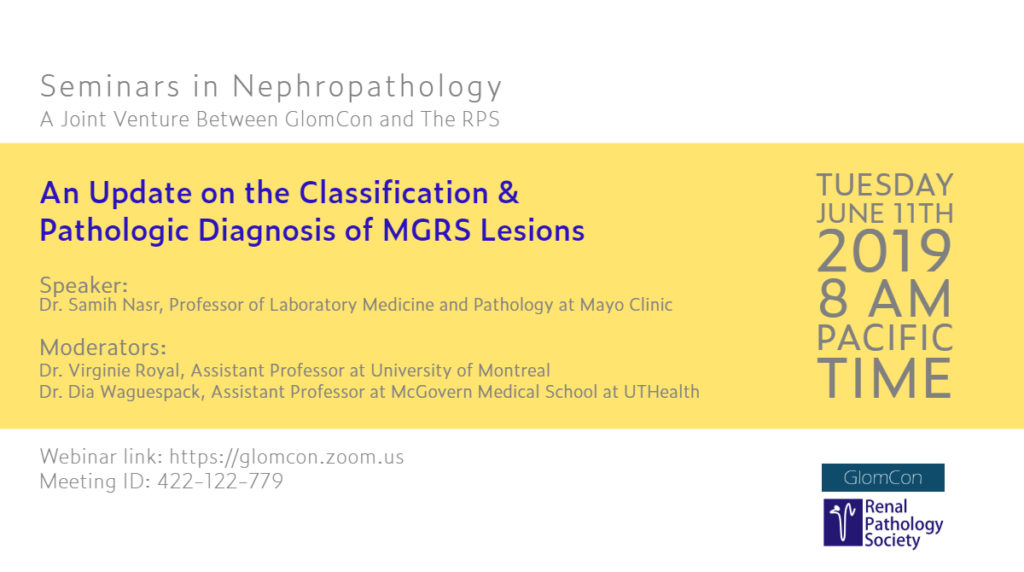SEMINARS IN NEPHROPATHOLOGY
An Update on the Classification & Pathologic Diagnosis of MGRS Lesions
In this inaugural session of Seminars in Nephropathology, Dr. Samih Nasr reviewed the classification and pathologic diagnosis of MGRS lesions. Our Moderator’s Notes are derived from his live presentation.


By Dr. Pravir Baxi
Key points:
Monoclonal Gammopathy of Renal Significance (MGRS)
- Defined as: plasma cell and B-cell clonal proliferative disorders that produce nephrotoxic monoclonal immunoglobulin (Ig) but do not meet classic hematological criteria for treatment
- Term includes MGUS, Smoldering MM, Waldenstrom macroglobulinemia, CLL, and other B-cell lymphoproliferative disorders
- MGRS lesions are governed by the physicochemical properties of the monoclonal Ig
- Not every patient with monoclonal gammopathy + kidney disease has MGRS
- The following clinical scenarios should raise suspicion for MGRS and warrant further investigation with kidney biopsy if feasible:
- Monoclonal gammopathy and unexplained kidney disease
- CKD attributed to common risk factors but presenting with an atypical clinical course
- Monoclonal gammopathy and kidney disease in patients <50 years
- The following clinical scenarios should raise suspicion for MGRS and warrant further investigation with kidney biopsy if feasible:
Pathomechanisms of MGRS
- Ig deposition
- Ig resulting in complement and cytokine activation
- Precipitation/crystallization of Igs
MGRS-associated Renal Lesions: International Kidney and Monoclonal Gammopathy Research Group (IKMG) Categorization 2019
- Monoclonal Ig deposits
- Organized structure
- Fibrillar: Ig related amyloidosis, Monoclonal fibrillary GN
- Microtubular: Immunotactoid GN, Cryoglobulinemic GN type 1 & 2
- Inclusions or crystalline deposits: Light chain proximal tubulopathy, Crystal storing histiocytosis, (Cryo) crystalglobulin GN
- Non-organized structure: Monoclonal Ig deposition disease (MIDD), Proliferative GN and monoclonal Ig deposits (PGNMID), Miscellaneous (monoclonal membranous, anti-GBM, HSP)
- Organized structure
- No monoclonal Ig deposits
- C3 GN with monoclonal gammopathy
- TMA with monoclonal gammopathy
Pathologic Evaluation for Suspected MGRS
- Definitive diagnosis of MGRS requires a kidney biopsy
- Immunofluorescence (IF) on frozen tissue which will establish the diagnosis of MGRS
- Light and electron microscopy (LM, EM) help determine the specific MGRS lesion
- Limitations: 1) Lack of tissue/technology (LM, IF, EM), 2) IgG subtype staining needed, 3) Monoclonal Ig can be masked, truncated or very sparse
- Ancillary techniques to establish pathologic diagnosis of MGRS
- IF on paraffin tissue (instead of frozen tissue) after antigen retrieval by a protease
- Valuable salvage method that is more sensitive for certain MGRS lesions and may be needed for lesions with masked deposits (e.g. membranous-like GN with masked IgG kappa deposits)
- Helpful in non-renal complications of paraprotein diseases (e.g. paraprotein-induced crystalline keratopathy)
- IF staining for IgG subtypes
- Helps support monoclonality of IgG+ LC restriction and aids in differentiating amongst the MGRS lesions
- Only works with frozen tissue and it alone does not provide definitive evidence for monoclonality
- Laser microdissection/mass spectrometry
- Useful in a subset of patients with renal amyloidosis
- Not clinically validated for non-amyloid MGRS lesions
- Immunoelectron microscopy
- IF on paraffin tissue (instead of frozen tissue) after antigen retrieval by a protease
Selected References:
https://www.ncbi.nlm.nih.gov/pubmed/30510265
https://www.ncbi.nlm.nih.gov/pubmed/23047823
https://www.ncbi.nlm.nih.gov/pubmed/29114004
https://www.ncbi.nlm.nih.gov/pubmed/30450452



